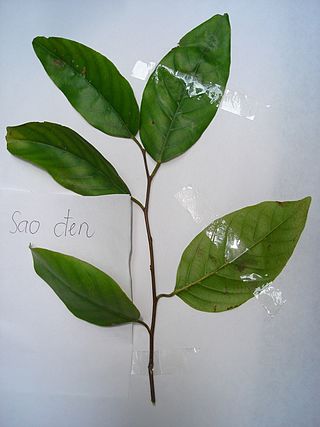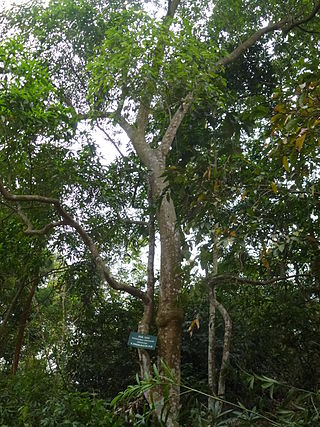
Annona reticulata is a small deciduous or semi-evergreen tree in the plant family Annonaceae. It is best known for its fruit, called custard apple, a common name shared with fruits of several other species in the same genus: A. cherimola and A. squamosa. Other English common names include ox heart and bullock's heart. The fruit is sweet and useful in preparation of desserts, but is generally less popular for eating than that of A. cherimola.

Camellia reticulata is a species of flowering plant in the tea family Theaceae, native to southwestern China, in Yunnan and Sichuan Provinces.
Matisia exalata is a species of flowering plant in the family Malvaceae sensu lato or Bombacaceae. It is found only in Panama. It is threatened by habitat loss.

Helicia is a genus of 110 species of trees and shrubs, constituting part of the plant family Proteaceae. They grow naturally in rainforests throughout tropical South and Southeast Asia, including India, Sri Lanka, Indochina, Peninsular Malaysia to New Guinea and as far south as New South Wales.

Hopea is a genus of plants in the family Dipterocarpaceae. It contains some 113 species, distributed from Sri Lanka and southern India to the Andaman Islands, Myanmar, southern China, and southward throughout Malesia to New Guinea. They are mainly main and subcanopy trees of lowland rainforest, but some species can become also emergent trees, such as Hopea nutans.
Hopea celebica is a species of plant in the family Dipterocarpaceae. It is native to Sulawesi.
Hopea chinensis is a species of medium-sized tree in the family Dipterocarpaceae. It is found in China and northern Vietnam.
Hopea gregaria is a species of plant in the family Dipterocarpaceae. It is native to Sulawesi. It is an endangered species threatened by habitat loss.

Hopea hainanensis is a species of tree in the family Dipterocarpaceae. It is found in Hainan Island of China and northern Vietnam. Hopea hainanensis produces the acetylcholinesterase inhibitor Hopeahainol A.
Hopea malibato is a species of plant in the family Dipterocarpaceae. It is endemic to the Philippines.
Hopea nigra is a species of plant in the family Dipterocarpaceae. It is a tree endemic to Sumatra. It is a critically endangered species.
Hopea nutans is a large rainforest tree species in the family Dipterocarpaceae. It is found in Peninsular Malaysia and Borneo. The tallest measured specimen is 82.8 m tall in the Tawau Hills National Park, in Sabah on the island of Borneo.

Hopea odorata is a species of plant in the family Dipterocarpaceae. It is found in Bangladesh, Cambodia, India, Laos, Malaysia, Myanmar, Thailand, and Vietnam. It is a large tree reaching up to 45 m (150 ft) in height with the base of the trunk reaching a diameter of 4.5 m (15 ft). It grows in forests, preferably near rivers, at elevations to 600 m (2,000 ft). In places such as West Bengal and the Andaman Islands it is often planted as a shade tree. Valued for its wood, it is a threatened species in its natural habitat.
Hopea plagata is a species of flowering plant in the family Dipterocarpaceae. It is found in Borneo and the Philippines. The tree grows to 55m tall.
Hopea reticulata is a species of tree in the family Dipterocarpaceae. It is found in Thailand and Vietnam. Some authors include Hopea exalata of Hainan, China to this species.
Hopea shingkeng was a species of plant in the family Dipterocarpaceae. It was endemic to the eastern Himalaya region of India.

Ixonanthes reticulata is a species of plant in the Ixonanthaceae family. It is native to an area from China to India to mainland and maritime Southeast Asia. The species is threatened by habitat loss. It is a broadleaf evergreen.

The Hainan Island monsoon rain forests ecoregion covers mountainous interior of Hainan Island in China. The tropical forests receive over 1,000 mm/year of rain, heavily concentrated in the summer rainy season. The island has high levels of biodiversity, with over 4,200 plant species, 630 of which are endemic to the island. The region is under ecological pressure from deforestation for agriculture and timber extraction.

Hopeanol is a highly cytotoxic resveratrol-derivative with the molecular formula C29H20O9 which has been isolated from the bark of the tree Hopea exalata.

Hopeahainol A is a polyphenol acetylcholinesterase inhibitor with the molecular formula C56H42O12. Hopeahainol A has been isolated from the tree Hopea hainanensis. Hopeahainol A may be used for the treatment of Alzheimer's disease.










